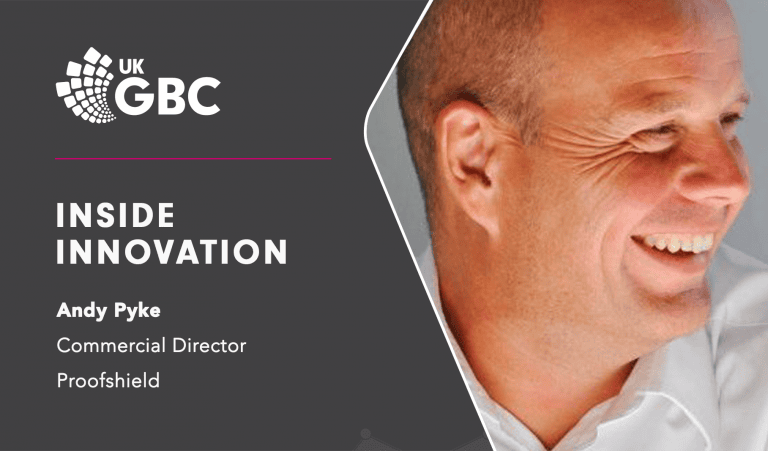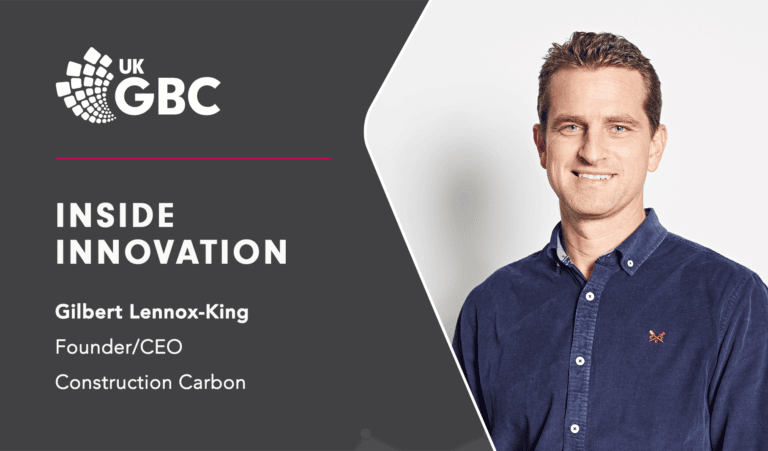Biohm

What is your elevator pitch?
‘Biohm is a research and development-led company that creates regenerative, high-performance materials and products for the built environment. We allow nature to lead innovation with the purpose of revolutionising the construction industry to create a healthier, regenerative built environment. We place natural systems at the heart of our inspiration, otherwise known as biomimetics. This combines the philosophies of the circular economy with human-led design and future technology. The idea is to create a set change in building technologies and materials as well as manufacturing methods – leading the entire sector to a more circular future. We’ve developed manufacturing processes that harness the power of nature, to transform production by creating closed-loop systems which are low energy and low carbon. We couple that with our biotech technologies in manufacturing to capture difficult-to-reuse organic waste and synthetic excess resources, waste from construction, agriculture and the food sectors. It is this that is then bio-manufactured into our products.
Drawing on these principles, we’ve developed an organic insulation panel from Mycelium (the root structure of mushrooms). Current testing shows that it outperforms many synthetic alternatives, and we can do that at competitive price because we don’t rely on any manufacturing, but rather natural processes to grow materials. The biggest factor in the types of buildings that the Mycelium products can be implemented relates to its fire rating. It’s a natural material and so the best it can get is a Class B fire rating which limits it to a certain height of building. We’ve also developed an organic refuse bio compound that we call Org and that utilises organic by-products such as food waste to create natural and regenerative materials to save on semi-structural wood based and plastic sheet-based materials, like MDF and plywood.
These larger scale construction materials are currently going through the process of testing and accreditation which is a very long-drawn-out process in the construction sector. Whilst we are going through that process, we’ve utilised our capacity to offer services to industry to help them focus on creating circular systems with their waste streams and help them decarbonise their businesses. We also do bespoke interior items such as lampshades and acoustic panels to commercialise some aspects of the technology which is settled and doesn’t require the testing that construction materials have to go through.
Who is your target audience?
It’s a mix of different companies. We’ve done a lot of work with land management companies, the largest in the UK. Equally, property developers, those doing large housing developments, are also very keen and understand the process of certification and the EPDs and are willing to put a bit more thought into their procurement. We have a lot of contact with individual buyers. It’s a really broad range between multinational construction companies and national property developers, small-scale property developers and single homeowners.
How did your start up get to where it is today?
The initial idea came from our founder Ehab. He did a research project 7 years ago looking at waste streams in the construction sector, everything from materials delivered on site to demolition. In line with a lot of other studies, he found a lot of waste that can’t be reused, or that people aren’t willing to reuse. It sent him down a path of looking at how waste can generally be reduced in construction in the first phase of a building’s life. He developed a construction system called Triagomy which designed to fit together without any bindings or fastenings. It can be taken apart at the beginning of its life so that it can be moved around, reconfigured or (at the end of its life) be taken away/put up again somewhere else if the parts are still viable. One of the biggest questions from our trials is what was this system going to be made of? That’s when we turned our attention to biomaterials. Ideally, at end of life, we would want these materials to be used in products that are higher up in the hierarchy or, at worst case, be naturally composted. We’re developing rigid boards that we want to turn into a plant-based concrete material to form parts of this system, as well as the Mycelium insulation. We started with a construction system and then refocused our efforts onto what the constituent parts of a regenerative construction system look like.
We’ve just had our first round of funding. We’ve been on a few programs, and through a number of accelerators: people who have helped us focus on our materials, how we actually run a business like ours, as well as programs that really integrated us into circular economy, particularly in and around London (for example Re:London a few years ago). The programs helped with developing the strategy around bringing the products to market. It was more business-focused. One of the programs was really looking at our commercial function and how to operate in that space, how the parts work, more about setting out our business model and proposition for investors. When you’re a start-up you’re pretty naïve about it.
What does innovation mean to you?
Innovation is about understanding the system in which you operate. Its not necessarily about creating a product that’s different, but about creating a product that truly addresses all of the issues involved in its production, use and end-of-life, so you are not just sending materials out into the world and not caring what happens to them. Innovation, in that sense, is about creating something that is regenerative. As interesting as new things may be, you really need to get past the point of sustainability with everything we’re doing. Personally, I don’t find the idea of sustainability to be particularly inspiring. Its basically just saying, “Lets just not make things worse”. It’s not exactly a call to action. Making regenerative processes, making things better than they are today, is where everything needs to be.
How hungry is the built environment for innovation?
It’s a mixed picture. We’ve spoken to organisations where this is at the forefront of what they want to achieve in their path for the next few years. We’ve also spoken to organisations that struggle with innovation in general, but particularly novel technologies. There’s a lot of willingness out there, particularly from individuals in companies. More generally, there’s a bit of a slow uptake. I don’t get the impression that companies think that it’s not important, but a lot of them are very large organisations that take a long time to turn around for a whole host of reasons. Generally, there’s certainly a recognition that things have to change, but it’s a bit of a mixed picture as to how that change is achieved.
What needs to change to help encourage more innovation?
Standards need to evolve as quickly as the world around them. That is certainly something that we’ve experienced, the standards for what we are doing not necessarily being present yet. Without that, industry doesn’t have the assurance that it needs to go through with new materials. The two need to walk hand in hand into the future. The willingness is there, but the system needs to catch up a bit. Fluidity with standards and the organisations that set them is important, to be more mindful that new materials are on the horizon and their role in accommodating them. Without that accommodation, there’ll never be the kind of uptake that’s needed to make a real difference. Construction is very heavily regulated, meaning that it’s all very slow.
What are the biggest challenges you have faced as a start-up?
Its multifaceted. Some of the things that we’ve experienced is a lack of understanding about what biomaterials are and what they mean. The glacial pace of change within the sector is another challenge. Though it is not something we have experienced, there may be the challenge of skills shortages industry-wide. Funding has never really been an issue for us. We’ve been incredibly lucky with our investors, but it’s certainly something that others have faced, particularly with more traditional forms of venture capital funding – understanding biomaterials is a severe anathema to them. The interplay between the immediate goals of any venture capitalist is profit or being able to sell the company at some point. Doing things for our own benefit doesn’t really align with the long-term view of the climate emergency which may mean that short-term profit is not really a reality.
What’s your advice for new innovators and start-ups in the built environment?
Tenacity, you’ll get there. It’s a long walk and you need to be prepared for it. Spend as much time as possible understanding how the system works because it is complex beyond my initial imagination. It is a challenge, understanding what you need to do, particularly in certification as a start-up, overwhelming at times. I would suggest reaching out to organisations willing to help, people like the BBA who are going back to their initial aim of bringing new interesting innovative materials to market rather than just services the larger company innovation. Reach out to organisations like that at your earliest possible opportunity. That’s how we did a lot of our market research. Other start-ups who develop their product and then consider certifying it can often come up against all sorts of surprises that they were not aware of.
What’s next for your company?
It’s about manufacturing at scale. Getting our products accredited. We’ve got a number of exciting partners that were having conversations with about developing that. Once we get accreditation, we need to get the funding to do full size production facilities.
Related
Grid2.0

Inside Innovation: Proofshield

Inside Innovation: Brainbox AI: Interview with COO Frank Sullivan

Inside Innovation: Construction Carbon

